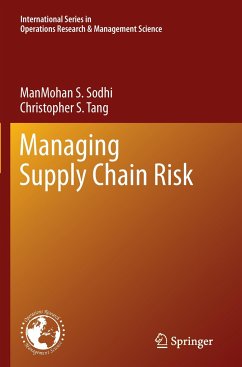
Engineering Risk and Finance
Versandkostenfrei!
Versandfertig in 6-10 Tagen
121,99 €
inkl. MwSt.
Weitere Ausgaben:

PAYBACK Punkte
61 °P sammeln!
Risk models are models of uncertainty, engineered for some purposes. They are "educated guesses and hypotheses" assessed and valued in terms of well-defined future states and their consequences. They are engineered to predict, to manage countable and accountable futures and to provide a frame of reference within which we may believe that "uncertainty is tamed". Quantitative-statistical tools are used to reconcile our information, experience and other knowledge with hypotheses that both serve as the foundation of risk models and also value and price risk. Risk models are therefore common to mos...
Risk models are models of uncertainty, engineered for some purposes. They are "educated guesses and hypotheses" assessed and valued in terms of well-defined future states and their consequences. They are engineered to predict, to manage countable and accountable futures and to provide a frame of reference within which we may believe that "uncertainty is tamed". Quantitative-statistical tools are used to reconcile our information, experience and other knowledge with hypotheses that both serve as the foundation of risk models and also value and price risk. Risk models are therefore common to most professions, each with its own methods and techniques based on their needs, experience and a wisdom accrued over long periods of time.
This book provides a broad and interdisciplinary foundation to engineering risks and to their financial valuation and pricing. Risk models applied in industry and business, heath care, safety, the environment and regulation are used to highlight their variety while financial valuation techniques are used to assess their financial consequences.
This book is technically accessible to all readers and students with a basic background in probability and statistics (with 3 chapters devoted to introduce their elements). Principles of risk measurement, valuation and financial pricing as well as the economics of uncertainty are outlined in 5 chapters with numerous examples and applications. New results, extending classical models such as the CCAPM are presented providing insights to assess the risks and their price in an interconnected, dependent and strategic economic environment. In an environment departing from the fundamental assumptions we make regarding financial markets, the book provides a strategic/game-like approach to assess the risk and the opportunities that such an environment implies. To control these risks, a strategic-control approach is developed that recognizes that many risks resultingby "what we do" as well as "what others do". In particular we address the strategic and statistical control of compliance in large financial institutions confronted increasingly with a complex and far more extensive regulation.
This book provides a broad and interdisciplinary foundation to engineering risks and to their financial valuation and pricing. Risk models applied in industry and business, heath care, safety, the environment and regulation are used to highlight their variety while financial valuation techniques are used to assess their financial consequences.
This book is technically accessible to all readers and students with a basic background in probability and statistics (with 3 chapters devoted to introduce their elements). Principles of risk measurement, valuation and financial pricing as well as the economics of uncertainty are outlined in 5 chapters with numerous examples and applications. New results, extending classical models such as the CCAPM are presented providing insights to assess the risks and their price in an interconnected, dependent and strategic economic environment. In an environment departing from the fundamental assumptions we make regarding financial markets, the book provides a strategic/game-like approach to assess the risk and the opportunities that such an environment implies. To control these risks, a strategic-control approach is developed that recognizes that many risks resultingby "what we do" as well as "what others do". In particular we address the strategic and statistical control of compliance in large financial institutions confronted increasingly with a complex and far more extensive regulation.














